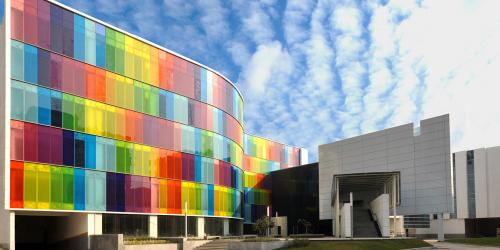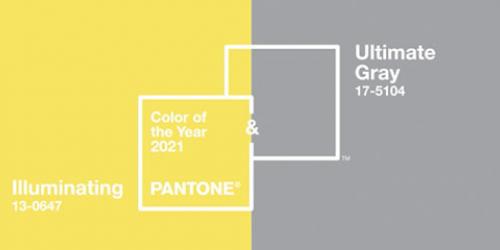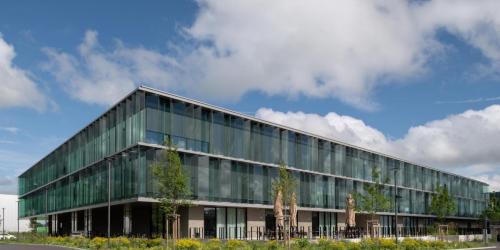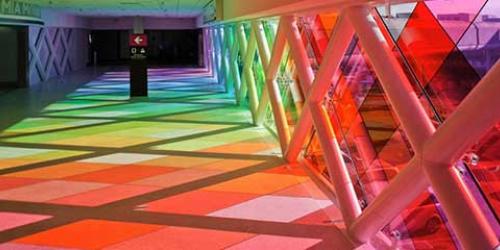Testing foundation Vanceva Color portfolio
This year, Eastman retested its foundation Vanceva Color portfolio, Vanceva color codes 0001-0008 (shown in Figure 1), as well as its three translucent white colors (Vanceva Arctic Snow, Cool White, and Polar White) according to the UV radiation tests of EN ISO 12543-4. The tests were executed at an accredited lab. All products passed with a wide margin relative to the requirements set out in EN ISO 12543-2, which is important because it is the key test for durability of optical properties in this standard. Furthermore, laminated glass producers that produce to the quality standard EN 14449 can rely on the interlayer manufacturer to provide proof of compliance with the requirements derived from this test.
Figure 1. Vanceva foundational color palette
The results of the recent test were compared to the oldest test reports available for these products to this standard, mostly dating back to between 2001 and 2007. To interpret the results, an understanding of the requirements of this standard is needed. According to EN ISO 12543-2 §5.3, no change of the visible light transmittance in any of the three specimens measured is acceptable if more than:
- 3% of their value before exposure for initial light transmittances is greater than 65% (relative change)
- 2% of their absolute value for initial light transmittances is less than or equal to 65% (absolute change)
The maximum 3% relative change applies to Vanceva colors Coral Rose, Aquamarine, Smoke Grey, Sahara Sun, and Golden Light. The maximum 2% absolute change applies to Vanceva colors Ruby Red, Sapphire, and Evening Shadow. In addition, no bubbles, delamination, haze, or cloudiness shall appear on exposure of the test specimens.
Comparison of the data
For ease of comparison, the relevant change (either absolute or relative, as relevant for the product) was averaged over the three specimens measured. No values were averaged that had a different sign. The results are represented in Table 1.
Table 1. Relevant change of visible light transmittance (VLT) for the foundational Vanceva colors of Figure 1 (measured in 3-mm clear glass)
| Vanceva color name | Vanceva color code | VLT change, 2001–2007 era test reports | VLT change, 2021 test reports |
| (%) | (%) | ||
| Coral Rose | VCV0001 | 0.2 | 0.1 |
| Aquamarine | VCV0002 | –0.1 | –0.1 |
| Smoke Grey | VCV0003 | –0.3 | –0.2 |
| Sahara Sun | VCV0004 | –0.1 | 0.0 |
| Ruby red | VCV0005 | 0.2 | 0.0 |
| Sapphire | VCV0006 | –0.2 | –0.1 |
| Evening Shadow | VCV0007 | 0.0 | –0.1 |
| Golden Light | VCV0008 | –0.1 | –0.1 |
Not only are the measured changes small compared to the allowed changes, they also have not significantly changed over the years. The Vanceva foundational colors are as stable with exposure to UV radiation as they were 15 years ago, which is a tribute to the quality ingredients, manufacturing practices, and processes in place around the production of these interlayers.
Other methods of Vanceva assessment
Other methods used by Eastman to assess durability of Vanceva interlayers include natural exposure in demanding climates, such as Florida and Arizona, as well as other accelerated exposure tests, such as Xenon arc or EMMA® exposures. Some of these tests are needed to meet the requirements of other standards like ANSI Z79.1.
Although standardized testing and natural exposure of Vanceva interlayers are very important, the ultimate test case is the stability of these interlayers in buildings. Peckham Library in London, U.K., was one of the first buildings to use the Vanceva foundational color palette over a large part of the glazing in the facade.
It has been 20 years since the completion of the Peckham Library, then part of a major urban revitalization of the borough of Southwark. The building was remarkable at the time for several unique architectural twists—its inverted L-shape, the open communal space under the cantilevered extension, the three elevated pods in the main library, and the use of Vanceva® Color interlayer system for the colored laminated glass panels for the cladding. In 2000, the library was awarded Britain’s most celebrated architectural award, the Stirling Prize, for its “extraordinary and innovative design.” Alsop & Stormer, the architects of the library’s unique design, fully satisfied the client’s desire for a building that would bring a sense of pride and ownership to the community while rejuvenating the borough.
Today, the library is an excellent example of real-time aging and proves that that Vanceva Color interlayers endure. The colors remain rich and vibrant like the day they were installed. As this iconic building has become emblematic of its neighborhood, the library stands as a testament to the durability of the Vanceva laminated glass system. After a quality check on site, it was determined that the glass had no apparent discoloration or edge fading. This is especially notable for the orange and green colors where, by definition, yellow pigments are present. Since they were installed, none of the glass panels have been replaced, and the colors appear as brilliant as they were then.
When color is introduced in a facade through the Vanceva Color system—using laminated glass prepared in accordance with the Eastman’s lamination guide—there is no need to worry over permanence of the color. These interlayers meet the requirements of the international product standard for laminated glass by a wide margin and have withstood the test of time.











